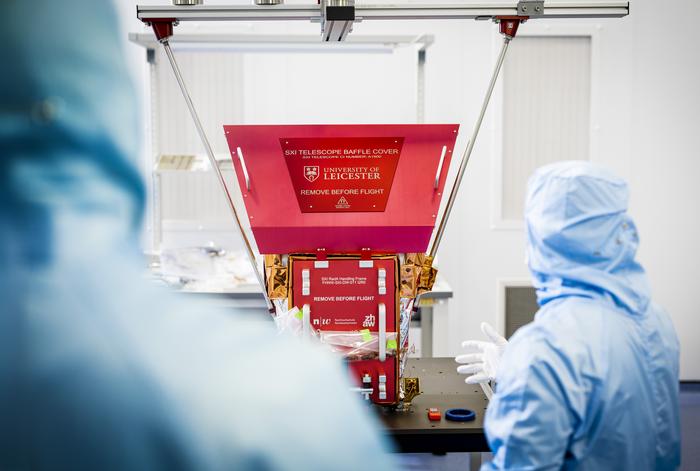Work on building a cutting-edge x-ray telescope has been completed and the final instrument handed over, to be integrated into a spacecraft that will make new insights into the solar winds that bombard our planet’s magnetosphere.

Credit: University of Leicester/Space Park Leicester
Work on building a cutting-edge x-ray telescope has been completed and the final instrument handed over, to be integrated into a spacecraft that will make new insights into the solar winds that bombard our planet’s magnetosphere.
The Soft X-ray Imager (SXI) on the Solar wind Magnetosphere Ionosphere Link Explorer (SMILE) is led by the University of Leicester and is a wide-field X-ray telescope that uses micropore optics to spectrally map the location, shape, and motion of Earth’s magnetospheric boundaries.
It has been developed and built in collaboration between the University of Leicester, Mullard Space Science Laboratory (MSSL) and the Open University within the United Kingdom and several institutions across Europe. UK space engineers have provided key subsystems in the form of the main telescope assembly, X-ray optics module, advanced X-ray detector system and the associated readout electronics.
It is the first instrument to be delivered using facilities at Space Park Leicester, as the Assembly, Integration and Test (AIT) Team successfully integrated space-flight subsystems to complete the SXI Telescope within a purpose-built cleanroom.
After a programme of development including building several models of the instrument which are subjected to environmental tests characteristic of the harsh environment of space, the final flight model of the instrument has been built and delivered to Airbus Defence and Space, Madrid, for integration onto the European Space Agency (ESA) platform that constitutes the main instrument hub on the SMILE spacecraft.
The Solar wind Magnetosphere Ionosphere Link Explorer (SMILE) is a joint collaborative science mission between ESA and the Chinese Academy of Sciences (CAS) that will study how the solar wind interacts with the Earth’s magnetic environment. It is due for launch from September 2025 on an ESA Vega-C rocket from Kourou in French Guiana.
Over the coming months, SXI and the other instruments which constitute the SMILE payload will have their systems tested in conjunction with the platform prior to integration of the whole spacecraft at the European Space Technology Centre (ESTEC) in the Netherlands.
Dr Steven Sembay, SMILE SXI Principal Investigator at the University of Leicester, said: “SXI is a powerful but compact X-ray telescope that has been challenging to design within the constraints on size and mass and the space environment imposed by the SMILE mission. It has been a real team effort to meet and get past all these challenges and is a testament to both the technical skill of our University-based engineers here in the UK and the great collaborative atmosphere all across our international consortium.”
Dr Jennifer Carter from the University of Leicester School of Physics and Astronomy said: “Our Earth is protected from the solar wind by its magnetic field, which acts like a shield. SMILE will transform our understanding of this highly dynamic magnetosphere.
“SXI will image this magnetic shield, whilst a different camera will take ultraviolet pictures of aurora in the Northern Hemisphere. For the first time ever, we will see how changes to this shield cause effects in the upper atmosphere at the same time.”
Dr Colin Forsyth from Mullard Space Science Laboratory, the SMILE Co-Principal Investigator at the Mission level, said: “SXI is crucial to the innovative observations that SMILE will provide, enabling us to reveal the invisible structures and processes around Earth, so it is very exciting to see this key instrument ready to go.”
Dr Caroline Harper, Head of Space Science, UK Space Agency said: “This a major milestone for Space Park Leicester and a huge achievement for the University of Leicester who led this international team to develop the cutting-edge instrumentation for SMILE, that will help us to understand more about the solar wind and how space weather can impact Earth.
“Space weather was responsible for the beautiful auroras that got the whole of the UK staying up, and looking up, in May 2024. It also brings potential risks such as radio blackouts, disruptions to satellites, and power grid failures. So it is vital we build our understanding and gain new insights into the solar winds that bombard our planet’s magnetosphere.
“The UK Space Agency has supported the delivery of this instrument with approximately £13m of funding, building on our mission to invest in cutting-edge technologies and world class science that bring the benefits of space back to citizens on Earth. We look forward to the next steps in the project.”



